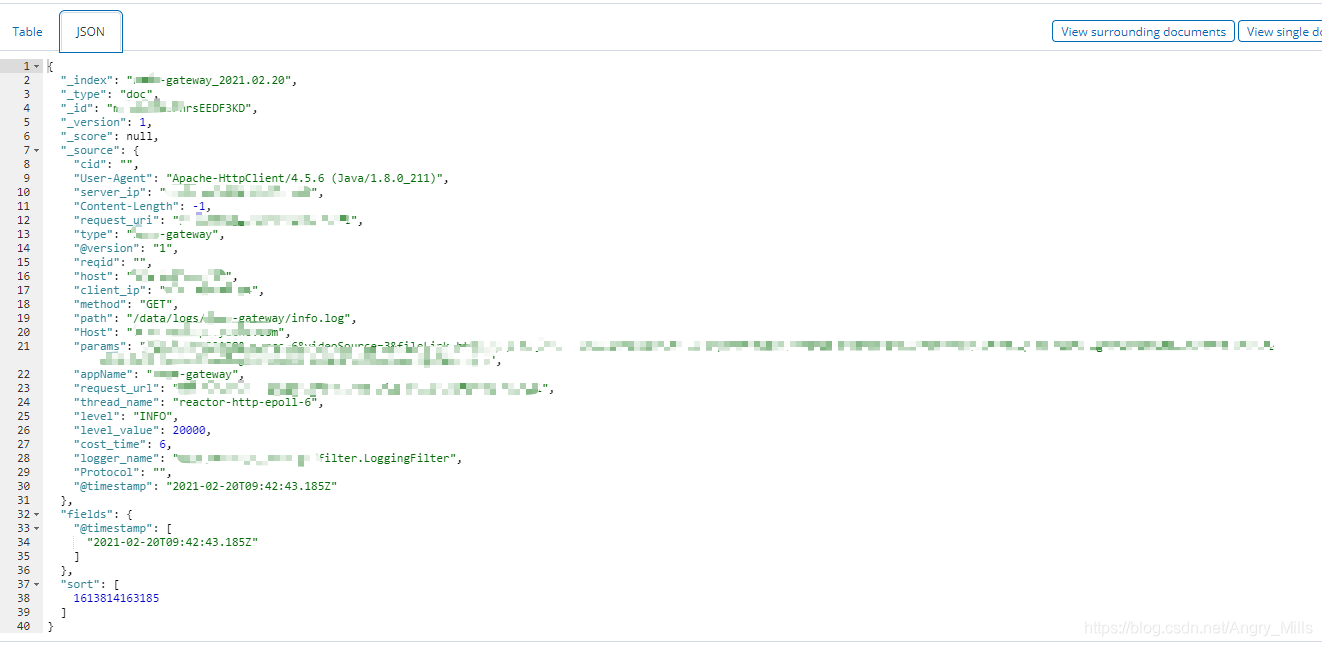大家好,我是烤鸭:
最近用 springcloud gateway 时,想使用类似 logback-access的功能,用来做数据统计和图表绘制等等,发现没有类似的功能,只能自己开发了。
环境:
<dependency>
<groupId>org.springframework.cloud</groupId>
<artifactId>spring-cloud-starter</artifactId>
</dependency>
<dependency>
<groupId>org.springframework.cloud</groupId>
<artifactId>spring-cloud-starter-gateway</artifactId>
</dependency>
整体思路
logback-access.jar 只需要在logback.xml 配置 LogstashAccessTcpSocketAppender 即可完成异步的日志上报。
如果采用相同的方式,考虑到同一个进程里异步上报占性能。(其实是开发太麻烦了)
这里采用的本地日志文件 + elk。
仿照 logback-access ,定义要收集的字段,开发过滤器收集字段,自定义 logstash.yml。
收集到的字段:
“User-Agent” : 请求头字段
“server_ip” :服务器ip
“Content-Length” : 请求参数长度
“request_uri” :请求路径(网关转发的路径)
“host” :本机ip
“client_ip” :请求ip
“method” :get/post
“Host” : 请求头字段
“params” :请求参数
“request_url” :请求全路径
“thread_name” :当前线程
“level” :日志级别
“cost_time” : 请求耗时
“logger_name” :日志类
“Protocol” : 请求头字段
代码实现
LoggingFilter
package com.xxx.gateway.filter;
import com.alibaba.fastjson.JSONObject;
import com.google.common.collect.Maps;
import lombok.extern.slf4j.Slf4j;
import org.apache.commons.lang3.StringUtils;
import org.springframework.cloud.gateway.filter.GatewayFilterChain;
import org.springframework.cloud.gateway.filter.GlobalFilter;
import org.springframework.core.Ordered;
import org.springframework.core.io.buffer.DataBuffer;
import org.springframework.core.io.buffer.DataBufferUtils;
import org.springframework.http.HttpHeaders;
import org.springframework.http.HttpMethod;
import org.springframework.http.server.reactive.ServerHttpRequest;
import org.springframework.http.server.reactive.ServerHttpRequestDecorator;
import org.springframework.stereotype.Component;
import org.springframework.util.CollectionUtils;
import org.springframework.util.MultiValueMap;
import org.springframework.web.server.ServerWebExchange;
import reactor.core.publisher.Flux;
import reactor.core.publisher.Mono;
import java.nio.charset.StandardCharsets;
import java.util.Map;
@Slf4j
@Component
public class LoggingFilter implements GlobalFilter, Ordered {
private static final String UNKNOWN = "unknown";
private static final String METHOD = "method";
private static final String PARAMS = "params";
private static final String REQUEST_URI = "request_uri";
private static final String REQUEST_URL = "request_url";
private static final String CLIENT_IP = "client_ip";
private static final String SERVER_IP = "server_ip";
private static final String HOST = "Host";
private static final String COST_TIME = "cost_time";
private static final String CID = "cid";
private static final String CONTENT_LENGTH = "Content-Length";
private static final String PROTOCOL = "Protocol";
private static final String REQID = "reqid";
private static final String USER_AGENT = "User-Agent";
private static final String START_TIME = "gw_start_time";
private static final String LOGINFOCOLLECTOR = "logInfoCollector";
/**
* Process the Web request and (optionally) delegate to the next {@code WebFilter}
* through the given {@link GatewayFilterChain}.
*
* @param exchange the current server exchange
* @param chain provides a way to delegate to the next filter
* @return {@code Mono<Void>} to indicate when request processing is complete
*/
@Override
public Mono<Void> filter(ServerWebExchange exchange, GatewayFilterChain chain) {
ServerHttpRequest request = exchange.getRequest();
String requestUrl = request.getPath().toString();
Map<String, Object> logInfoCollector = Maps.newLinkedHashMap();
logInfoCollector.put(CLIENT_IP, getIpAddress(request));
logInfoCollector.put(SERVER_IP, request.getURI().getHost());
logInfoCollector.put(HOST, getHeaderValue(request, HOST));
logInfoCollector.put(METHOD, request.getMethodValue());
logInfoCollector.put(REQUEST_URI, request.getURI().getPath());
logInfoCollector.put(REQUEST_URL, getRequestUrl(request));
logInfoCollector.put(PARAMS, request.getURI().getQuery());
logInfoCollector.put(CID, getHeaderValue(request, CID));
logInfoCollector.put(CONTENT_LENGTH, request.getHeaders().getContentLength());
logInfoCollector.put(PROTOCOL, getHeaderValue(request, PROTOCOL));
logInfoCollector.put(REQID, getHeaderValue(request, REQID));
logInfoCollector.put(USER_AGENT, getHeaderValue(request, USER_AGENT));
exchange.getAttributes().put(START_TIME, System.currentTimeMillis());
exchange.getAttributes().put(LOGINFOCOLLECTOR, logInfoCollector);
String requestMethod = request.getMethodValue();
String contentType = exchange.getRequest().getHeaders().getFirst(HttpHeaders.CONTENT_TYPE);
String contentLength = exchange.getRequest().getHeaders().getFirst(HttpHeaders.CONTENT_LENGTH);
if (HttpMethod.POST.toString().equals(requestMethod) || HttpMethod.PUT.toString().equals(requestMethod)) {
// 根据请求头,用不同的方式解析Body
if ((Character.DIRECTIONALITY_LEFT_TO_RIGHT + "").equals(contentLength) || StringUtils.isEmpty(contentType)) {
MultiValueMap<String, String> getRequestParams = request.getQueryParams();
log.info("\n 请求url:`{}` \n 请求类型:{} \n 请求参数:{}", requestUrl, requestMethod, getRequestParams);
return chain.filter(exchange);
}
Mono<DataBuffer> bufferMono = DataBufferUtils.join(exchange.getRequest().getBody());
return bufferMono.flatMap(dataBuffer -> {
byte[] bytes = new byte[dataBuffer.readableByteCount()];
dataBuffer.read(bytes);
String postRequestBodyStr = new String(bytes, StandardCharsets.UTF_8);
if (contentType.startsWith("multipart/form-data")) {
log.info("\n 请求url:`{}` \n 请求类型:{} \n 文件上传", requestMethod);
} else {
log.info("\n 请求url:`{}` \n 请求类型:{} \n 请求参数:{}", requestMethod, postRequestBodyStr);
}
// 后续需要用到参数的可以从这个地方获取
exchange.getAttributes().put("POST_BODY", postRequestBodyStr);
logInfoCollector.put(PARAMS, postRequestBodyStr);
DataBufferUtils.release(dataBuffer);
Flux<DataBuffer> cachedFlux = Flux.defer(() -> {
DataBuffer buffer = exchange.getResponse().bufferFactory().wrap(bytes);
return Mono.just(buffer);
});
// 下面的将请求体再次封装写回到request里,传到下一级,否则,由于请求体已被消费,后续的服务将取不到值
ServerHttpRequest mutatedRequest = new ServerHttpRequestDecorator(exchange.getRequest()) {
@Override
public Flux<DataBuffer> getBody() {
return cachedFlux;
}
};
// 封装request,传给下一级
return chain.filter(exchange.mutate().request(mutatedRequest).build()).then(Mono.fromRunnable(() -> {
Long startTime = exchange.getAttribute(START_TIME);
Map<String, Object> logInfo = exchange.getAttribute(LOGINFOCOLLECTOR);
if (startTime != null && !CollectionUtils.isEmpty(logInfo)) {
Long executeTime = (System.currentTimeMillis() - startTime);
logInfo.put(COST_TIME, executeTime);
log.info(JSONObject.toJSONString(logInfo));
}
}));
});
} else if (HttpMethod.GET.toString().equals(requestMethod)
|| HttpMethod.DELETE.toString().equals(requestMethod)) {
return chain.filter(exchange).then(Mono.fromRunnable(() -> {
Long startTime = exchange.getAttribute(START_TIME);
Map<String, Object> logInfo = exchange.getAttribute(LOGINFOCOLLECTOR);
if (startTime != null && !CollectionUtils.isEmpty(logInfo)) {
Long executeTime = (System.currentTimeMillis() - startTime);
logInfo.put(COST_TIME, executeTime);
log.info(JSONObject.toJSONString(logInfo));
}
}));
}
return chain.filter(exchange);
}
public String getIpAddress(ServerHttpRequest request) {
HttpHeaders headers = request.getHeaders();
String ip = headers.getFirst("x-forwarded-for");
if (StringUtils.isNotBlank(ip) && !UNKNOWN.equalsIgnoreCase(ip)) {
// 多次反向代理后会有多个ip值,第一个ip才是真实ip
if (ip.indexOf(",") != -1) {
ip = ip.split(",")[0];
}
}
if (StringUtils.isBlank(ip) || UNKNOWN.equalsIgnoreCase(ip)) {
ip = headers.getFirst("Proxy-Client-IP");
}
if (StringUtils.isBlank(ip) || UNKNOWN.equalsIgnoreCase(ip)) {
ip = headers.getFirst("WL-Proxy-Client-IP");
}
if (StringUtils.isBlank(ip) || UNKNOWN.equalsIgnoreCase(ip)) {
ip = headers.getFirst("HTTP_CLIENT_IP");
}
if (StringUtils.isBlank(ip) || UNKNOWN.equalsIgnoreCase(ip)) {
ip = headers.getFirst("HTTP_X_FORWARDED_FOR");
}
if (StringUtils.isBlank(ip) || UNKNOWN.equalsIgnoreCase(ip)) {
ip = headers.getFirst("X-Real-IP");
}
if (StringUtils.isBlank(ip) || UNKNOWN.equalsIgnoreCase(ip)) {
ip = request.getRemoteAddress().getAddress().getHostAddress();
}
return ip;
}
private String getRequestUrl(ServerHttpRequest request) {
String url = request.getURI().toString();
if (url.contains("?")) {
url = url.substring(0, url.indexOf("?"));
}
return url;
}
private String getHeaderValue(ServerHttpRequest request, String key) {
if (StringUtils.isEmpty(key)) {
return "";
}
HttpHeaders headers = request.getHeaders();
if (headers.containsKey(key)) {
return headers.get(key).get(0);
}
return "";
}
/**
* Get the order value of this object.
* <p>Higher values are interpreted as lower priority. As a consequence,
* the object with the lowest value has the highest priority (somewhat
* analogous to Servlet {@code load-on-startup} values).
* <p>Same order values will result in arbitrary sort positions for the
* affected objects.
*
* @return the order value
* @see #HIGHEST_PRECEDENCE
* @see #LOWEST_PRECEDENCE
*/
@Override
public int getOrder() {
return HIGHEST_PRECEDENCE;
}
}
logstash.yml
input {
file {
path => "D:/data/logs/ccc-gateway/*.log"
type => "ccc-gateway"
codec => json {
charset => "UTF-8"
}
}
}
filter {
json {
source => "message"
skip_on_invalid_json => true
add_field => {
"@accessmes" => "%{
message}" }
remove_field => [ "@accessmes" ]
}
}
output {
elasticsearch {
hosts => "localhost:9200"
index => "ccc-gateway_%{
+YYYY.MM.dd}"
}
}
上面的 logstash.yml 兼容 json和非json格式,loggingFilter 会保证数据打印为json格式,其他的地方log也可以是非json的。
效果如图
accesslog:

其他的log:

图表绘制
其实netty 作为容器本身也是有 acesslog的,可以开启。
-Dreactor.netty.http.server.accessLogEnabled=true
AccessLog的log方法直接通过logger输出日志,其日志格式为COMMON_LOG_FORMAT({} - {} [{}] "{} {} {}" {} {} {} {} ms),分别是address, user, zonedDateTime, method, uri, protocol, status, contentLength, port, duration

没有请求参数和自定义参数(一般链路id放在请求头里的)和响应参数(这次也没加),所以算是对accesslog做了改进。下图是访问量和平均耗时,后续还可以加tp99,请求路径等等
访问量:

平均耗时:
